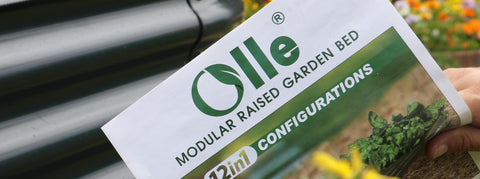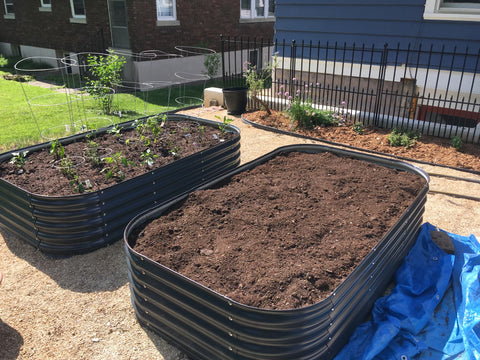Tips from Olle Garden Bed: How to Plant Almost Anything
Use these important planting techniques to dust your dreams, make you confident and have fun.The following content also has some reference value for raised garden beds.

Do you dream of a life full of crispy vegetable salad? Or put a bunch of colorful flowers on your bedside table, coffee table and kitchen counter? Maybe it's as simple as growing a basil bowl for homemade pesto sauce. We can easily continue, because the pleasure of planting an edible or ornamental garden will still excite even the most experienced green thumb.
But from soil to spacing to watering, you need to consider a lot of things before you plant any style of garden in depth. Experienced growers may remember their methods, but beginners will want to follow some trusted advice on how to grow vegetables, flowers and herbs in containers, elevated beds or underground gardens. If it's you, this is your guide.
Work with the weather
If you live in a cool climate, please wait until the frost is over before planting anything outdoors. Watch for a sunny day, or at least an extended forecast without extreme weather patterns (spring can be so unpredictable!). Once conditions are good and stable, set aside time for planting in the morning or evening. When the sun is not directly overhead, you and your flora will be happier, even on mild days.

It is best to avoid planting under dry conditions. If this is not an option, make sure you can always keep an eye on your garden and water - but responsibly - until your seeds germinate or your plants grow well.
Prepare your soil
High quality soil can ensure that your plants get the necessary nutrients and water when they settle and grow. The loose and rich mixture allows the roots to stretch and has enough space for air and water to flow down, around and through them.
- Subterranean soil
Usually, the land already in your yard needs nutrition supplement. To improve the existing soil in the underground garden, loosen it with a rake or fork, break up any dense lumps and remove any rocks while moving.
- Elevated bed soil
Because you work above the ground, you can start an elevated bed garden with ideal soil conditions. Spread the bed to the top and spread the soil evenly in each corner. Press it gently with your hand or shovel.
- Container garden soil
Before planting anything in the container, check whether there are drain holes at the bottom of the container. (Depending on the material, you can add them using a drill bit.) The drain hole allows any excess water to continue to flow through the root and out of the pot through the soil, thus protecting your plant from root rot.

Create enough space
Resist the temptation to put seeds or plants closer than the package or label suggests - believe in the label! Use a ruler or tape measure to measure how far apart they should be before you start digging. Remember, the small seed you planted may grow into a plant hundreds of times larger! Before long, they will grow up and reward you with plenty of fresh vegetables, delicious herbs and beautiful flowers.
Proper plant spacing - for container gardens, containers of appropriate size - allows your plants to expand their roots while absorbing water and key nutrients from the soil. It also prevents overcrowding as they grow. The air that circulates through your garden will help your plants avoid disease and pests.
Find the right depth
Different seeds have different needs, and so do starting plants. However, one aspect remains unchanged: they need to be placed in sufficient soil. Covering them with proper amount of soil will provide suitable temperature for seed germination or high-quality root growth of starting plants. Check the information on the package to understand the depth of excavation.
Before placing the initial plants underground or in the overhead garden, give them some water in their temporary pots. Then, rake the soil surface of the bed and check it for moisture. If it sticks to the rake, it will be too wet. Also, if it looks dry, add a little water. Once the soil is good and fragile, excavate according to the recommended depth on the plant label. You can observe it with your eyes, or check it with a tape measure before putting the root ball of each plant into the hole, and then fill the soil around it. Firm and gentle, ensuring that all roots are covered and that each root can stand upright without any support. Next, give them a large glass of water to help eliminate any air pockets and place them in a comfortable new arrangement.
When putting the starting plant into the container, wet the pot mixture at the bottom of the pot. Put the root ball of each plant into the pot, the depth of which is roughly the same as that of the container, and fill more pot mixture on both sides until the root is covered. Press the soil around the base with your hands to make the surface smooth and stable. Check whether the plant is firmly standing in the center of the pot and add water.
If you are planting in a raised or underground bed, please read the packaging to know the recommended planting method and depth. Rake and wet the soil surface, then choose one of two styles: groove or mound, depending on what you plant. The mound is more suitable for plants such as melons or pumpkins, while the trough is suitable for lettuce or carrots.

For the groove, use your fingers to create a long, shallow groove and push loose soil to both sides of the groove. Evenly spread the seeds into the tank, and then spread the soil on the top again. The mound method is similar, but you need to make a small mound about 6 inches high, and poke a few holes at the top, about 2 inches apart. Put a seed in each hole and gently put the soil back on top. In either case, tap the soil and give it plenty of water. (Maybe you have some yourself, because you are working hard!) Once the seeds germinate, you may need to thin them - pick the seedlings individually or cut them horizontally on the surface with scissors - to avoid crowding.
When sowing in containers, select vegetables, herbs and flowers that grow well in small spaces, and containers that are large enough to accommodate plants when they reach full size.
Water immediately
Even if they are already planted in slightly damp soil, your seeds and starter plants need more water. Welcome them to their new home, and soak thoroughly near the roots - where plants need it most - to help promote growth.
If you have planted a starter plant underground or on an elevated bed, water it slowly with a hose or watering can. (Avoid leaves as much as possible, because wet leaves can cause disease.) Continue watering until a puddle forms on the soil surface, and then take a few minutes to rest before watering again. One more look at the puddle and you're done!
The same is true for the initial plants in the container, but instead of the water pit on the surface, they are looking for the water flowing from the bottom. Once there is a considerable amount of water flowing out of the drain hole, you can guess: take a break and water again.
Think of the newly planted seeds as their babies, giving them a softer touch when watering them. Thoroughly (but carefully) wet the soil with a watering can or hose, which is equipped with a sprinkler attachment and set on a soft fog. Be careful not to wash away the soil layer covering and protecting the seeds. Let the hen fight against nature: water regularly and keep in front of the sun and wind, which will keep the soil moist until the seeds begin to germinate. Once they do, you will see small green seedlings sticking out from the top of the soil. Relax and say hello to your new friend!

Now, for the follow-up. Plan to water your underground or elevated bed garden every day for the first week, and then reduce the frequency of watering. Throughout the growing season, containers will continue to require daily or more frequent watering. A little pot makes them thirsty!
Make it a habit to check the soil every day, no matter which garden you plant. If you put your finger one inch into the top and feel dry, or your plant grows slowly, loses color, or withers, you need to water it. Doing so early in the day or late in the afternoon will help more water penetrate into the soil and promote stronger roots.
